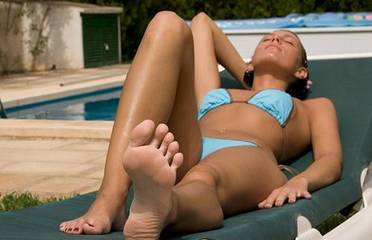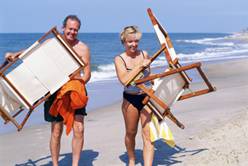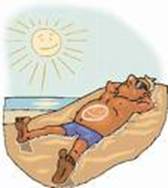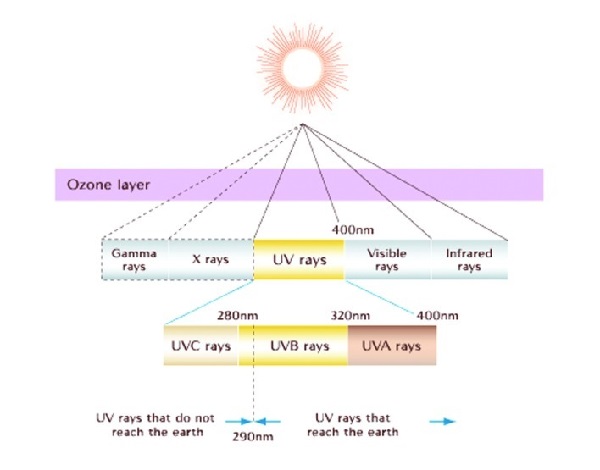The sunbath for vitamin D

Without doubt, the best source of Vitamin D is moderate and consistent sun exposure
Ideally, we need ~5,000 I.U. daily vitamin D from all sources
Unfortunately, many people do not get enough D. One recent study suggests that vitamin D deficiency is reaching crisis levels, with more than 1 billion people worldwide deficient in this vital nutrient. Our loin-cloth wearing ancestors lived mainly outdoors, and with minimal exposure to strong sunlight were able to daily synthesize ~ 20,000 I.U. vitamin D . Today, we spend most of our time indoors and when we do go outside, we slather on sun-block, which prevents vitamin D production.
The elderly and those with dark skin are at much greater risk of D deficiency than others
The sun provides the best source for vitamin D, but for many people, sufficient sunshine exposure is not possible
Maybe lifestyle and work schedules do not allow enough time in the sun or if a resident of a northern (or far southern) climate? In these places, the sun is too low in the sky most of the year to produce adequate vitamin D. Fortunately, we are able to draw on vitamin D stored in fat for a few weeks or months, but then it becomes necessary to ensure other sources:
Supplement an oral or sublingual vitamin D3. However, to avoid overdosing you should have your calcidiol (25 [OH] D) levels checked for optimal not just average values. For more information on testing:
Use a safe tanning bed. Supplies full spectrum light;
Install full-spectrum light fixtures in your work or home. Includes visible, infrared and UV light to closely mimic natural light;
Eat oily fish and D3-fortified foods. E.g. salmon, milk and orange juice; Also, provitamin D2 can be obtained from sundried mushrooms.
Details matter on how best to sunbathe for vitamin D
- Bare skin (but don’t frighten the neighbors!)
- No sun-block
- No glasses
- No hat
- Sun high in the sky
- Do NOT get sunburnt!
Sunbathe between 10 and 2 for optimal D!
Exposing skin to sunlight’s UV-B for vitamin D3 production is best obtained between the hours of 10am and 2pm. Yes – exactly opposite to what you’ve been led to believe! Sun exposure at higher latitudes before 10 am or after 2 pm will cause burning from tanning UV-A rays before it will supply adequate vitamin D from UV-B. Sun exposure at higher latitudes before 10 am or after 2 pm will cause UV-A rays to burn the skin before adequate vitamin D3 from UV-B is produced in the skin. So, if you’re out early in the morning or late in the day or only getting your sun through the car or office window you get lots of tanning (free radical-producing) UV-A rays. This increases your risk of cancer if that’s your only sun intake and you fail to protect your skin. Note also that UV-A can break through the ozone layer, cloud cover, clothes and pollution and do its damage to skin. For a more detailed explanation:
UV-A vs. UV- radiation
And while on the subject of UV-A and UV-B :
- UV-B can destroy vitamin A in skin, but at a slower rate than UV-A ;
- Sunblock lotion absorbs UV-B , but not usually UV-A . An SPF 15 lotion absorbs ~93% UV-B
How long to sunbathe?
Depends on skin color/amount of melanin in skin / age / antioxidant levels /essential fats in diet/ latitude /season /time of day /altitude /cloud cover /pollution. As a rough guide, depending on UV-B level, full body exposure yields ~ 10-20,000 I.U. vitamin D into circulation for:
- Light skinned person. ~20-30 mins.
- Dark skinned person. ~60-120 mins.
“Listen” to your body – if the sun is being harmful, we feel uncomfortable, forcing us to withdraw from the sun’s rays before they can injure us.
Expose more than just face and hands, go nude if you dare
Aim to uncover at least 40% of your body:
“A full sunbath in the nude is ideal. This is not a mere cosmetic measure, but a health requirement for greatest value”
– Dr. Shelton
“Everyone sick or well looks better, feels better, gets better and functions better after exposing every part of their nude bodies to the beautiful sunshine”
– Bernarr McFadden
Do not get sunburnt
You need only enough exposure to have your skin turn the lightest shade of pink. Production in the skin occurs in minutes and is maximized before skin turns pink. Longer exposures will not produce any more vitamin D but will accelerate photo aging and increase your risk for non-melanoma skin cancers like basal and squamous cell cancer.
- Tanned Skin. Melanin (dark skin pigment) is nature’s built-in protection to:
- Prevent vitamin D overdose. Melanin efficiently absorbs UV-B , and thus prevents cutaneous production of vitamin D 3. Melanin is the reason why dark skinned races need much greater exposure time to UV-B radiation in order to produce vitamin D ;
- Protect against UV-A damage. Melanin also absorbs UV-A and thus prevents excess UV-A from damaging UV-A -absorbing DNA, RNA and proteins;
Build up sun exposure slowly and consistently. Rather than in sporadic intense bursts.
Minimize use of soap in shower for 48 hours after UV-B exposure
New evidence indicates that it takes about 48 hours for vitamin D -containing skin oils to be absorbed into the bloodstream. Using soap only on underarm, groin and backside takes care of hygiene without losing vitamin D . These skin oils can also be removed by chlorine in swimming pools.
Use of sunscreen lotions

There are times when it is necessary to use a sunscreen lotion. However, most commercial lotions available are toxic and cause more oxidant damage than they were designed to prevent. For guidance on choosing a sunscreen, understanding SPF numbers and information on “edible sunblock” nutrients:





















